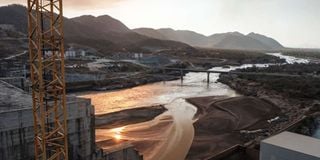Premium
Sudan worried over decline in Nile water levels as Ethiopia fills dam

What you need to know:
- Filling the reservoir, whose total capacity is 74 billion cubic meters, may take several years.
- Egypt seeks to prolong the period of the filling process to avoid the possible impacts of water shortage.
Khartoum
Sudan's Irrigation and Water Resources Ministry has disclosed that water levels on Nile River are declining, hinting at possible closure of the gates of the Grand Ethiopian Renaissance Dam (GERD).
This comes at a time when Ethiopia reportedly announced it had started filling the dam.
"Measuring the Blue Nile levels by the concerned authorities showed a decline in the water levels equivalent to 90 million cubic meters per day, which confirms the closure of the gates of the dam," said the ministry statement released on Wednesday.
The ministry further reiterated Sudan's rejection to any unilateral measures by any party relating to the GERD issue.
"The ministry renews its rejection to any unilateral measures by any party, particularly with the continued efforts to reach a consensus deal among the three countries on the outstanding issues of differences which can be overcome if there is political will," the statement said.
FOLLOWING GERD DEVELOPMENT
It reiterated that Sudanese authorities are following up the GERD development in order to secure the country’s national interests.
Earlier on Wednesday, Egypt sought an official clarification from Ethiopia on whether it had started filling the dam built on their shared Nile River as stated in some media reports.
"Egypt has requested an urgent official clarification from the Ethiopian government regarding the truth of this matter," Foreign Ministry Spokesman Ahmed Hafez said.
Ethiopia had recently said it would soon start filling the reservoir, while Egypt repeatedly warned against any unilateral action without a prior tripartite agreement.
On Monday, Sudan, Egypt and Ethiopia ended the recent round of tripartite talks on the GERD without reaching an agreement on the outstanding issue of filling of the dam.
Meanwhile, the three countries have sent separate reports to the African Union which is expected to call for a mini-summit next week to issue a decision regarding the Ethiopian dam.
Ethiopia started building the GERD in 2011, while Egypt, which is downstream the Nile Basin and relies on the river for its fresh water, is concerned that the dam might affect its 55.5 billion cubic-meter annual share of the water resources.
The USD4 billion GERD is expected to produce over 6,000 megawatts of electricity and become Africa's largest hydropower dam upon completion.
Filling the reservoir, whose total capacity is 74 billion cubic meters, may take several years.
Egypt seeks to prolong the period of the filling process to avoid the possible impacts of water shortage, which has been a main point of their talks.





